In the world of technological advancements, laptops have become an integral part of our lives. They provide us with the luxury of mobility and convenience. As an infopreneur laptops are a part of having an online business.
However, working solely on a laptop can sometimes be limiting, especially when it comes to connectivity and productivity. This is where a docking station for a laptop comes into play. So, what is a docking station for laptop?
This article is about what a docking station is for a laptop and its features. I will also list the highly rated docking station options. Having a docking station as part of your digital world is something you really need to have in your possession.
If after reading this article hopefully, you will make a sound decision. I am an affiliate marketer for Amazon plus it’s my favorite place to shop! It’s my favorite for convenience.
Why Amazon is the best place to buy your docking station for your laptop or computer device.
There are several reasons why many people consider Amazon to be a popular choice for buying products:
1. Wide Selection: Amazon offers a vast range of products across various categories, giving customers a wide selection to choose from.
2. Competitive Pricing: Amazon often offers competitive prices, discounts, and deals on many products, making it an attractive option for shoppers looking for excellent value.
3. Convenience: Amazon provides a convenient shopping experience with features like fast shipping, easy returns, and a user-friendly website and app interface.
4. Customer Reviews: Amazon allows customers to leave reviews and ratings for products, which can help potential buyers make informed decisions based on the experiences of others.
5. Trust and Reliability: Amazon has built a reputation for being a reliable and trustworthy platform, with secure payment options and a robust customer support system.
It’s important to note that while Amazon may be a popular choice for many, individual preferences and needs may vary.
It’s always a clever idea to compare prices, read reviews, and consider other factors before making a purchase decision.
Definition and Functionality
A docking station is a device that allows a laptop to connect to various peripherals and devices, transforming it into a desktop workstation.
It provides additional ports and connectivity options, expanding the capabilities of a laptop and enhancing user experience.
Seamless Transition
When using a laptop with a docking station, you can effortlessly transition between using it on the go and transforming it into a powerful workstation by simply docking and undocking the laptop.
This enables users to enjoy the benefits of both portability and productivity.
Enhanced Connectivity
One of the significant advantages of using a docking station is the increased connectivity options it offers.
Typically, a docking station provides additional USB ports, audio jacks, Ethernet ports, and video outputs such as HDMI, DisplayPort, or VGA. This allows you to connect multiple devices simultaneously without the need for cumbersome cable management.
Simplified Cable Management
By using a docking station, you can eliminate the hassle of constantly plugging and unplugging different cables each time you need to use a different device.
Instead, you can leave your peripherals and devices connected to the docking station, reducing cable clutter, and making your workspace more organized.
Example: Imagine having a docking station with four USB ports, an HDMI output, and an Ethernet port.
You can keep your mouse, keyboard, external hard drive, and printer connected to the docking station while also plugging in an external monitor and accessing network resources through a wired connection.
Increased Productivity
With a docking station, you can enhance your productivity by connecting multiple monitors to your laptop.
This feature is especially beneficial for professionals who require a multi-display setup, as it allows for a more efficient workflow and provides a larger viewing area.
Example: Let’s say you are a graphic designer. By connecting two extra monitors to your laptop via the docking station, you can have your design software open on one screen, your reference images on another, and your email or music player on the laptop screen.
Charging and Power Delivery
Some docking stations also offer power delivery, allowing you to charge your laptop while it is connected.
This feature is particularly useful if you have a limited number of power outlets available or if you want to extend your laptop’s battery life during extended periods of use.
Compatibility and Portability
Docking stations are designed to be compatible with various laptop models and brands. This versatility ensures that you can use the same docking station even if you switch laptops, eliminating the need to purchase a new docking station every time you upgrade your device.
Additionally, docking stations are compact and lightweight, making them portable and easy to carry while traveling.
Here are 5 highly-rated docking stations on Amazon right now!
Top 5 Highly Rated Docking Station
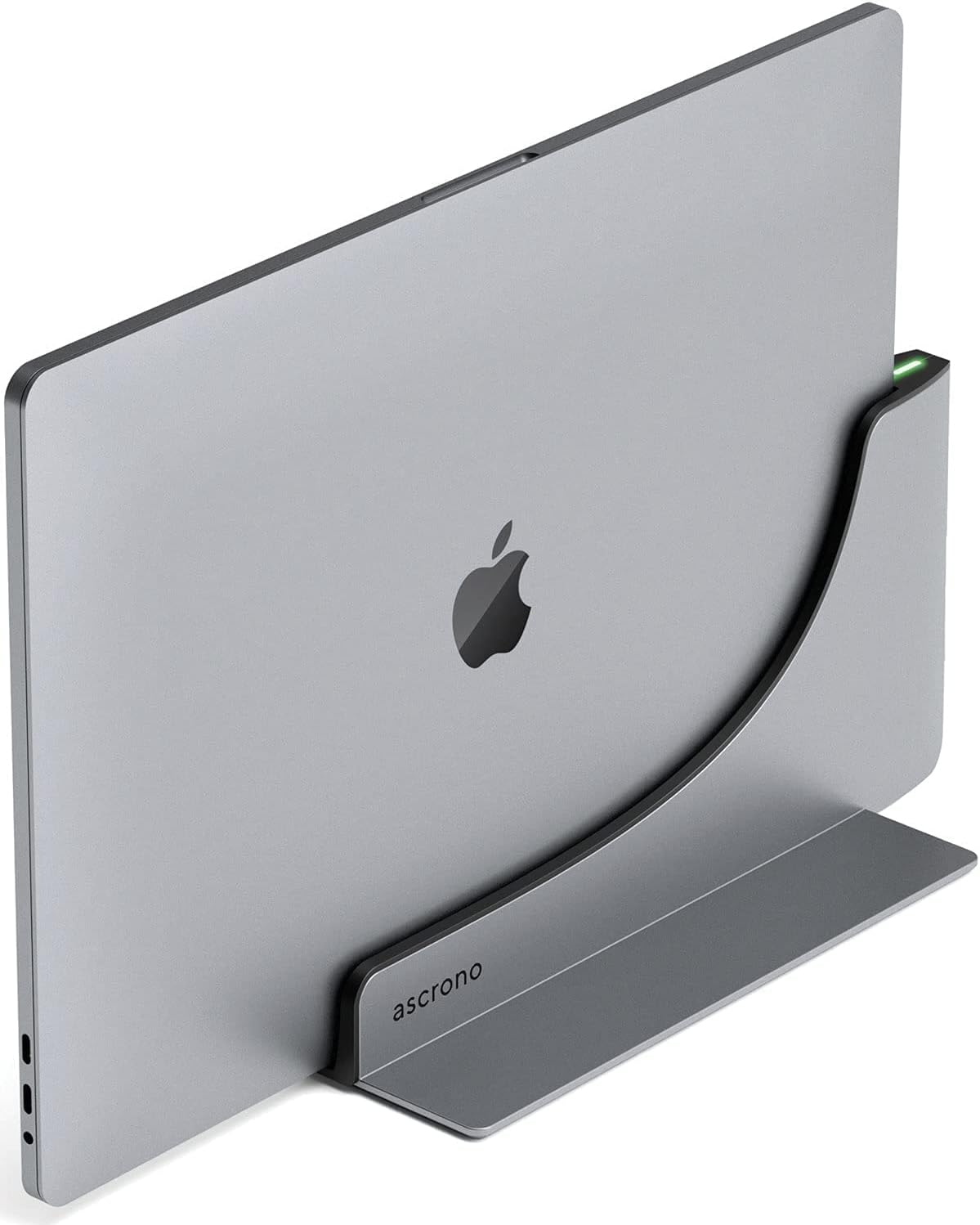
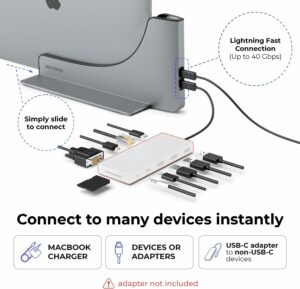
About this item
SEAMLESS DESKTOP CONVERSION – Elevate your MacBook Pro’s experience into a fully functional desktop setup with the Ascrono Vertical Docking Station. Slide in your MacBook for instant device connectivity, indicated by a green light and instantly switch between on-the-go efficiency and desktop productivity.
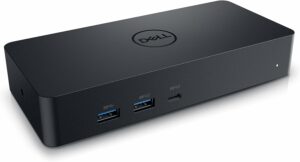
About this item
Universal Docking Solutions: Conveniently attach any laptop equipped with USB-C or USB-A and connect easily to displays, keyboard and mouse, and audio devices whether at home or in the office.
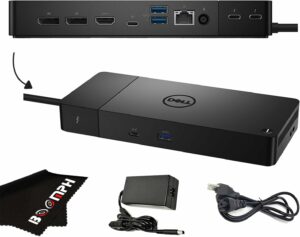
About this item
Provides up to 130W of Power Delivery. 2 x Thunderbolt 4 Port. 2 x DisplayPort 1.4 Port. 1 x HDMI 2.0 Port. 1 x USB 3.2 Gen 2 Type-C Port. 1 x USB Type-C Multifunction DisplayPort. 3 x USB 3.2 Gen 1 Type-A Port. 1 x Gigabit Ethernet RJ45 LAN Jack. Modular Design.
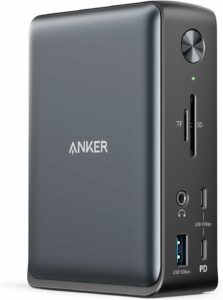
About this item
Huge Expansion: Equipped with an 85W laptop-charging USB-C port, an 18W Power Delivery USB-C port, a USB-C data port, 3 USB-A ports, 2 HDMI ports, a DisplayPort, an Ethernet port, SD/microSD card slots, a 3.5 mm AUX port, and a DC input.
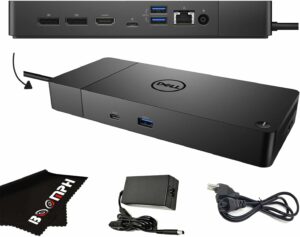
About this item
USB Type-C Host Connection | 90W Power Delivery / 130W Power Adapter. 3 x USB 3.1 Gen 1 Type-A Ports | 2 x USB 3.1 Gen 1 Type-C Ports. 2 x DisplayPort, 1 x HDMI Port | 1 x RJ45 Gigabit Ethernet Port. 3840 x 2160 Max Resolution @ 60 Hz | Includes 130W Power Adapter. Includes USB Type-C Cable | Noble Wedge & Kensington Security Slots.
Conclusion
In conclusion, a docking station for a laptop is a versatile device that enhances connectivity, productivity, and convenience.
It allows users to seamlessly transition from a portable laptop to a full-fledged workstation and provides a wide range of connectivity options.
Whether you are a professional seeking a multi-display setup or someone looking to simplify cable management, a docking station can improve your laptop experience. So, consider investing in this invaluable tool and revolutionize the way you work!
Please share your thoughts on the topic and feel free to leave your comments below. Your feedback is highly appreciated and welcomed.
Follow me on all social media platforms!
Stay connected by signing my email list.

Thanks for the clear and informative breakdown of docking stations! I never realized how much convenience they could add to a workspace until I started using one myself. Being able to connect multiple peripherals with just one plug has been a game-changer for my productivity, especially when transitioning between my home office and other setups.
One thing I’ve been curious about is whether there’s a noticeable difference in performance between different types of docking stations. For instance, are there any specific features or specs you’d recommend prioritizing if someone needs their setup for intensive tasks like video editing or gaming? I’d love to hear your thoughts!
Hi Editor,
I’m so glad you found the post helpful, and I agree—once you start using a docking station, it’s hard to imagine returning! The convenience it brings, especially when managing multiple devices or shifting between workspaces, makes a difference.
When choosing a docking station for more intensive tasks like video editing or gaming, performance is critical. There are a few essential features to prioritize. First, I’d recommend looking for a docking station that supports high-speed data transfer, ideally with Thunderbolt 3 or 4. These can handle more bandwidth, which is crucial for tasks like video editing. Thunderbolt ports also allow you to connect multiple high-resolution monitors without a hitch.
Next, if you’re connecting power-hungry peripherals like external hard drives or monitors, make sure the docking station supports power delivery. This will ensure that your devices stay charged and help avoid interruptions.
If you’re editing videos or gaming, dual or triple monitor support can be another essential feature, especially with 4K displays. Be sure the docking station can handle the display resolution and refresh rate you need for a smooth experience.
Lastly, if your workflow relies on many external devices, consider the number and variety of ports (USB-C, HDMI, DisplayPort, Ethernet, etc.), so you’re not limited when it comes to connecting all your peripherals.
I hope this helps! If you have any other questions about optimizing your setup, feel free to let me know—I’d love to help further.
Best,
Jamie London Clay